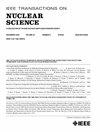IF 1.9
3区 工程技术
Q3 ENGINEERING, ELECTRICAL & ELECTRONIC
引用次数: 0
摘要
高能宇宙辐射探测设施(HERD)是中国空间站(CSS)中中国宇宙灯塔计划的一部分,计划于2027年发射。高能宇宙辐射探测设施预计在轨运行十年,将能够间接探测暗物质、测量宇宙射线和观测高能伽马射线。作为HERD的子探测器,过渡辐射探测器(TRD)的主要科学目标是在TeV能量范围内校准电磁量热计(CALO),提高CALO的测量精度,并探测高能伽马射线的天文现象。在这项工作中,我们设计了前端电子装置(FEE),作为 HERD TRD 原型的标准读出单元。前端电子设备使用四块 SAMPA 专用集成电路(ASIC)来读取 128 个探测器信号,实现了高速、低功耗和高可靠性的数据采集系统。FEE 通过 RS-422 总线以通用异步接收发送器 (UART) 协议接收来自后端电子设备 (BEE) 的触发信号和串行命令,并回复 BEE,提供适当的远程环境和现场可编程门阵列 (FPGA) 状态参数。此外,FEE 还通过低压差分信号 (LVDS) 总线以 80 Mb/s 的速度发送检测器科学数据和时钟信号,并提供双通道热备份。根据电子设备的电气测试结果,通道的均方根噪声小于 1.7 fC,线性度优于 0.2%。此外,还在欧洲核子研究中心(CERN)的超级质子同步加速器(SPS)和质子同步加速器(PS)终端上进行了束流测试,以验证拟议系统的电子性能。结果表明,拟议的 FEE 能够满足 TRD 原型的读出要求,并能准确获得μ介子和电子的能谱。本文章由计算机程序翻译,如有差异,请以英文原文为准。
Front-End Electronics Design for the Transition Radiation Detector Prototype in the HERD
The high-energy cosmic radiation detection facility (HERD) is a part of the Chinese Cosmic Lighthouse Program in China space station (CSS), which is planned for launch in 2027. The HERD is expected to operate for ten years in orbit, and it will be able to indirectly detect dark matter, measure cosmic rays, and observe high-energy gamma rays. As a subdetector of the HERD, a transition radiation detector (TRD) has the main scientific goal of calibrating the electromagnetic calorimeter (CALO) at the TeV energy range, improving the measurement accuracy of the CALO, and detecting astronomical phenomena of high-energy gamma rays. In this work, we designed the front-end electronics (FEEs) as a standard readout unit for the TRD prototype in the HERD. The FEE uses four SAMPA application-specific integrated circuits (ASICs) for 128 detector signal readouts, realizing a high-speed, low-power, and high-reliability data acquisition system. The FEE receives trigger signals and serial commands from the back-end electronics (BEEs) using the universal asynchronous receiver transmitter (UART) protocol via an RS-422 bus and replies to the BEE, providing appropriate remote environmental and field-programmable gate array (FPGA) status parameters. In addition, the FEE sends detector scientific data and clock signals via a low-voltage differential signaling (LVDS) bus at 80 Mb/s with a dual-channel hot backup. According to the results of the electrical tests on the electronics, the channel’s root mean square (rms) noise is less than 1.7 fC, and the linearity is better than 0.2%. In addition, a beam test is performed on the super proton synchrotron (SPS) and proton synchrotron (PS) terminals of the European Organization for Nuclear Research (CERN) to verify the electronic performance of the proposed system. The results show that the proposed FEE can meet the readout requirements of the TRD prototype and can accurately obtain the energy spectrum of muons and electrons.
求助全文
通过发布文献求助,成功后即可免费获取论文全文。
去求助
来源期刊

IEEE Transactions on Nuclear Science
工程技术-工程:电子与电气
CiteScore
3.70
自引率
27.80%
发文量
314
审稿时长
6.2 months
期刊介绍:
The IEEE Transactions on Nuclear Science is a publication of the IEEE Nuclear and Plasma Sciences Society. It is viewed as the primary source of technical information in many of the areas it covers. As judged by JCR impact factor, TNS consistently ranks in the top five journals in the category of Nuclear Science & Technology. It has one of the higher immediacy indices, indicating that the information it publishes is viewed as timely, and has a relatively long citation half-life, indicating that the published information also is viewed as valuable for a number of years.
The IEEE Transactions on Nuclear Science is published bimonthly. Its scope includes all aspects of the theory and application of nuclear science and engineering. It focuses on instrumentation for the detection and measurement of ionizing radiation; particle accelerators and their controls; nuclear medicine and its application; effects of radiation on materials, components, and systems; reactor instrumentation and controls; and measurement of radiation in space.
 求助内容:
求助内容: 应助结果提醒方式:
应助结果提醒方式:


